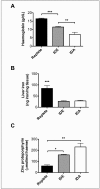Iron-deficient erythropoiesis in blood donors and red blood cell recovery after transfusion: initial studies with a mouse model
- PMID: 28263174
- PMCID: PMC5336338
- DOI: 10.2450/2017.0349-16
Iron-deficient erythropoiesis in blood donors and red blood cell recovery after transfusion: initial studies with a mouse model
Abstract
Background: Most frequent red cell (RBC) donors and many first-time donors are iron deficient, but meet haemoglobin standards. However, the effects of donation-induced iron deficiency on RBC storage quality are unknown. Thus, we used a mouse model to determine if donor iron deficiency reduced post-transfusion RBC recovery.
Methods: Weanling mice received a control diet or an iron-deficient diet. A third group receiving the iron-deficient diet was also phlebotomised weekly. This provided 3 groups of mice with different iron status: (1) iron replete, (2) mild iron deficiency with iron-deficient erythropoiesis, and (3) iron-deficiency anaemia. At ten weeks of age, blood was collected, leucoreduced, and stored at 4 ºC. After 12 days of storage, 24-hour (h) post-transfusion RBC recovery was quantified in recipients by flow cytometry.
Results: Before blood collection, mean haemoglobin concentrations in the iron-replete, iron-deficient, and iron-deficiency anaemia donor mice were 16.5±0.4, 11.5±0.4, and 7.0±1.4 [g/dL± 1 standard deviation (SD)], respectively (p<0.01 for all comparisons between groups). The 24-h post-transfusion RBC recoveries in recipients receiving transfusions from these three cohorts were 77.1±13.2, 66.5±10.9, and 46.7±15.9 (% ±1 SD), respectively (p<0.05 for all comparisons between groups).
Discussion: In summary, donor iron deficiency significantly reduced 24-h post-transfusion RBC recovery in recipient mice. RBCs from mice with mild iron deficiency and iron-deficient erythropoiesis, with haemoglobin levels similar to those used for human autologous blood donation, had intermediate post-transfusion RBC recovery, as compared to iron-replete donors and those with iron-deficiency anaemia. This suggests that, in addition to the effects of iron deficiency on donor health, frequent blood donation, leading to iron-deficient erythropoiesis, may also have adverse effects for transfusion recipients.
Conflict of interest statement
The Authors declare no conflicts of interest.
Figures




Similar articles
-
Donor Iron Deficiency Study (DIDS): protocol of a study to test whether iron deficiency in blood donors affects red blood cell recovery after transfusion.Blood Transfus. 2019 Jul;17(4):274-280. doi: 10.2450/2019.0066-19. Blood Transfus. 2019. PMID: 31385800 Free PMC article.
-
The strategies to reduce iron deficiency in blood donors randomized trial: design, enrolment and early retention.Vox Sang. 2015 Feb;108(2):178-85. doi: 10.1111/vox.12210. Epub 2014 Dec 3. Vox Sang. 2015. PMID: 25469720 Free PMC article. Clinical Trial.
-
A randomized trial of blood donor iron repletion on red cell quality for transfusion and donor cognition and well-being.Blood. 2022 Dec 22;140(25):2730-2739. doi: 10.1182/blood.2022017288. Blood. 2022. PMID: 36069596 Free PMC article. Clinical Trial.
-
Erythropoietin plus iron versus control treatment including placebo or iron for preoperative anaemic adults undergoing non-cardiac surgery.Cochrane Database Syst Rev. 2020 Aug 13;8(8):CD012451. doi: 10.1002/14651858.CD012451.pub2. Cochrane Database Syst Rev. 2020. PMID: 32790892 Free PMC article.
-
Impact of G6PD status on red cell storage and transfusion outcomes.Blood Transfus. 2019 Jul;17(4):289-295. doi: 10.2450/2019.0092-19. Blood Transfus. 2019. PMID: 31385801 Free PMC article. Review.
Cited by
-
Host serum iron modulates dengue virus acquisition by mosquitoes.Nat Microbiol. 2019 Dec;4(12):2405-2415. doi: 10.1038/s41564-019-0555-x. Epub 2019 Sep 16. Nat Microbiol. 2019. PMID: 31527795
-
Association of donor age, body mass index, hemoglobin, and smoking status with in-hospital mortality and length of stay among red blood cell-transfused recipients.Transfusion. 2019 Nov;59(11):3362-3370. doi: 10.1111/trf.15541. Epub 2019 Oct 11. Transfusion. 2019. PMID: 31602669 Free PMC article.
-
Frequent blood donations alter susceptibility of red blood cells to storage- and stress-induced hemolysis.Transfusion. 2019 Jan;59(1):67-78. doi: 10.1111/trf.14998. Epub 2018 Nov 26. Transfusion. 2019. PMID: 30474858 Free PMC article.
-
Association of Blood Transfusion From Female Donors With and Without a History of Pregnancy With Mortality Among Male and Female Transfusion Recipients.JAMA. 2017 Oct 17;318(15):1471-1478. doi: 10.1001/jama.2017.14825. JAMA. 2017. PMID: 29049654 Free PMC article.
-
Long-Term Course of Haemoglobin and Ferritin Values in High-Frequency Donors of Whole Blood and Double Erythrocyte Apheresis.Transfus Med Hemother. 2021 Mar;48(2):71-78. doi: 10.1159/000509026. Epub 2020 Aug 5. Transfus Med Hemother. 2021. PMID: 33976607 Free PMC article.
References
-
- Brittenham GM. Disorders of iron homeostasis: iron deficiency and overload. In: Hoffman R, Benz EJ, Silberstein LE, et al., editors. Hematology. 6th ed. Philadelphia: Elsevier/Saunders; 2013. pp. 437–49.
-
- Hastka J, Lasserre J-J, Schwarzbeck A, et al. Laboratory tests of iron status: correlation or common sense? Clin Chem. 1996;42:718–24. - PubMed
-
- Smith GA, Fisher SA, Doree C, Roberts DJ. A systematic review of factors associated with the deferral of donors failing to meet low haemoglobin thresholds. Transfusion Med. 2013;23:309–20. - PubMed
-
- Birgegard G, Schneider K, Ulfberg J. High incidence of iron depletion and restless leg syndrome (RLS) in regular blood donors: intravenous iron sucrose substitution more effective than oral iron. Vox Sang. 2010;99:354–61. - PubMed
MeSH terms
Substances
Grants and funding
LinkOut - more resources
Full Text Sources
Medical
